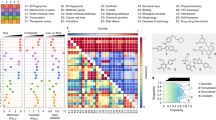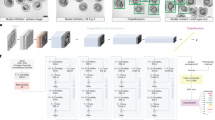Abstract
Target identification is a core challenge in chemical genetics. Here we use chemical similarity to computationally predict the targets of 586 compounds that were active in a zebrafish behavioral assay. Among 20 predictions tested, 11 compounds had activities ranging from 1 nM to 10,000 nM on the predicted targets. The roles of two of these targets were tested in the original zebrafish phenotype. Prediction of targets from chemotype is rapid and may be generally applicable.
This is a preview of subscription content, access via your institution
Access options


Similar content being viewed by others

References
Harding, M.W., Galat, A., Uehling, D.E. & Schreiber, S.L. Nature 341, 758–760 (1989).
Leung, D., Hardouin, C., Boger, D.L. & Cravatt, B.F. Nat. Biotechnol. 21, 687–691 (2003).
Ong, S.E. et al. Proc. Natl. Acad. Sci. USA 106, 4617–4622 (2009).
Mayer, T.U. et al. Science 286, 971–974 (1999).
Haggarty, S.J. et al. Chem. Biol. 7, 275–286 (2000).
Schreiber, S.L. Nat. Chem. Biol. 1, 64–66 (2005).
Seiler, K.P. et al. Nucleic Acids Res. 36, D351–D359 (2008).
Palchaudhuri, R. & Hergenrother, P.J. ACS Chem. Biol. 6, 21–33 (2011).
Lamb, J. et al. Science 313, 1929–1935 (2006).
Keiser, M.J., Irwin, J.J. & Shoichet, B.K. Biochemistry 49, 10267–10276 (2010).
Paolini, G.V., Shapland, R.H., van Hoorn, W.P., Mason, J.S. & Hopkins, A.L. Nat. Biotechnol. 24, 805–815 (2006).
Yildirim, M.A., Goh, K.I., Cusick, M.E., Barabasi, A.L. & Vidal, M. Nat. Biotechnol. 25, 1119–1126 (2007).
Keiser, M.J. et al. Nat. Biotechnol. 25, 197–206 (2007).
Keiser, M.J. et al. Nature 462, 175–181 (2009).
Kokel, D. et al. Nat. Chem. Biol. 6, 231–237 (2010).
Hert, J., Keiser, M.J., Irwin, J.J., Oprea, T.I. & Shoichet, B.K. J. Chem. Inf. Model. 48, 755–765 (2008).
Rogers, D. & Hahn, M. J. Chem. Inf. Model. 50, 742–754 (2010).
James, C., Weininger, D. & Delany, J. Daylight Theory Manual (Daylight Chemical Information Systems Inc., 2011).
Willett, P., Barnard, J.M. & Downs, G.M. J. Chem. Inf. Comput. Sci. 38, 983–996 (1998).
Altschul, S.F., Gish, W., Miller, W., Myers, E.W. & Lipman, D.J. J. Mol. Biol. 215, 403–410 (1990).
Young, D.W. et al. Nat. Chem. Biol. 4, 59–68 (2008).
Mestres, J., Gregori-Puigjane, E., Valverde, S. & Sole, R.V. Mol. Biosyst. 5, 1051–1057 (2009).
Alderton, W., Davenport, R. & Fish, P.V. Drugs Future 35, 517–521 (2010).
Kinnings, S.L. et al. PLOS Comput. Biol. 5, e1000423 (2009).
Hert, J., Irwin, J.J., Laggner, C., Keiser, M.J. & Shoichet, B.K. Nat. Chem. Biol. 5, 479–483 (2009).
Acknowledgements
We thank S. Morris for help with Cytoscape. This work was supported by US National Institutes of Health grants GM71896 (to J.J.I. and B.K.S.), AG02132 (to S. Prusiner and B.K.S.), MH085205 and MH086867 (to R.P.), MH091449 (to D.K.), R01 MH093603 and R01 NS49272 (to D.L.M.); a Rogers Family Foundation award (to M.J.K.); the National Institutes of Mental Health Psychoactive Drug Screening Program, grant U19MH82441; the Michael Hooker Chair (to B.L.R.); and fellowships from the Max Kade Foundation (to C.L.) and the European Molecular Biology Organization (to A.T.).
Author information
Authors and Affiliations
Contributions
The strategy was devised by B.K.S. and R.T.P., the PMR assay by D.K., and target predictions and other calculations by C.L., with assistance and editing by J.J.I., M.J.K., H.L. and B.K.S. Electrophysiology was designed by D.L.M. and implemented by A.T., and GPCR and kinase experiments were designed and implemented by B.L.R. and V.S., who also advised on target-phenotype associations. Zebrafish pharmacology was conducted by D.K. with assistance by C.Y.J.C.
Corresponding authors
Ethics declarations
Competing interests
The authors declare no competing financial interests.
Supplementary information
Supplementary Text and Figures
Supplementary Methods and Supplementary Results (PDF 4982 kb)
Rights and permissions
About this article
Cite this article
Laggner, C., Kokel, D., Setola, V. et al. Chemical informatics and target identification in a zebrafish phenotypic screen. Nat Chem Biol 8, 144–146 (2012). https://doi.org/10.1038/nchembio.732
Received:
Accepted:
Published:
Issue Date:
DOI: https://doi.org/10.1038/nchembio.732
This article is cited by
-
Zebrafish disease models in drug discovery: from preclinical modelling to clinical trials
Nature Reviews Drug Discovery (2021)
-
Statistical Analysis of Zebrafish Locomotor Behaviour by Generalized Linear Mixed Models
Scientific Reports (2017)
-
Drug screening: zebrafish as a tool for studying epileptic-related chemical compounds
Protein & Cell (2015)
-
Integrated phenotypic and activity-based profiling links Ces3 to obesity and diabetes
Nature Chemical Biology (2014)
-
Target identification and mechanism of action in chemical biology and drug discovery
Nature Chemical Biology (2013)


